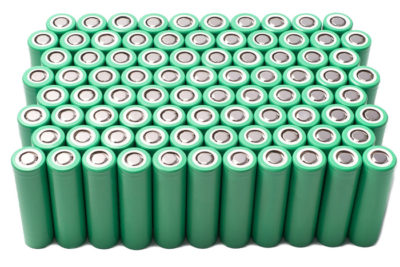P-FERTILIZER AND LITHIUM RECOVERY FROM BATTERIES —- Lithium iron phosphate
(LFP) batteries represent over 1/3 of the world market for lithium ion batteries, points out the
lab study entitled “Recycling Phosphorus From Spent LiFePO4 Battery For Multifunctional
Slow-Release Fertilizer Preparation and Simultaneous Recovery of Lithium” that presents a
process to recover lithium and a phosphate fertilizer. Currently LFP batteries are difficult to
recycle: regeneration leads to battery quality deterioration and strong acid dissolution results
in large quantities of wastewater and loss of the phosphorus. In this study, the batteries were
shredded, then the cathode material separated and processed. This resulted in an N-P-K
slow-release fertilizer material, containing approx. 18%N, 6.5%P, and some K. Recovery of
both lithium and phosphorus > 99% could be achieved. This recovered fertilizer material was
tested in pot trials with maize, showing significantly increased growth compared to control (no
comparison was made to commercial fertilizer). Tested heavy metals (Cd, As, Pb, Cr, Hg)
were below detection limit in the recovered N-P-K fertilizer, as were iron and sulphur.
Residues from the process were mainly NaFeS2 (used as a catalyst for degradation of
methylene blue and indigo carmine) and Na2SO4 (a commodity chemical). The authors
conclude that the process would offer significantly better profitability than recovery of lithium
only (lithium is <2% of LFP battery weight, whereas phosphorus (as P) is c. 17%).
SEWAGE SLUDGE INCINERATION ASH (SSIA) SHOWS LIMITED P-FERTILIZER
EFFICIENCY —- Pot trials of twelve SSIAs show P effectiveness 5–46% compared to
mineral P fertilizer TSP (comparable to 24% for phosphate rock), this is the conclusion of a
study whose results were presented in two articles — “Assessing and Predicting Phosphorus
Phytoavailability from Sludge Incineration Ashes” and “Influence of Sludge Incineration Ash
on Ryegrass Growth and Soil Phosphorus Status”. NAC P-solubility only explained around
50% of variation in effectiveness. Random forest analysis of the three parameters oxalate
extractable aluminium, phosphorus and iron was the best indicator of P-fertilizer
effectiveness, predicting about 80% of variability. The greenhouse pot trials used rye grass
grown for twelve weeks, in two soils (clay and sandy loam), pH 6–7. The SSIAs came from
11 municipal sewage sludge mono-incinerators in Canada and the USA, and one agri-food
processing plant incinerator. Ten of the eleven municipal plants used iron and/or aluminium
coagulants. Data for P, Fe, Al and other minerals in the twelve ashes are provided, as are
data for inorganic contaminants. The authors conclude that levels of heavy metals in the
SSIAs “do not appear to be of concern for agricultural use”, whereas six of the eleven
municipal sewage SSIAs show copper levels higher than the new EU Fertilizing Products
Regulation (FPR) 2019/1009 limit of 600 mgCu/kg limit for mineral fertilizers, two show zinc
levels higher than the FPR limit (1500 mgZn/kg) and three show lead levels higher than the
FPR limit (120 mgPb/kg).
POTENTIAL FOR P-RECOVERY FROM MEAT PROCESSING —- The study entitled
“Quantification of Material Recovery From Meat Waste Incineration – An Approach to an
Updated Food Waste Hierarchy” analyses data from a meat processing company and the lab
tests suggest that c. 13 ktP/y could be recovered from meat processing in Poland, by
calcining, to high quality hydroxyapatite (calcium phosphate, human food or animal feed
grade). ESPP notes that currently this recovered phosphate cannot be used in Europe
because the European Commission DG SANTE and EFSA have not yet defined an Animal
By Products Regulation ‘End Point’. The experimental work tested calcining (at 600–950°C)
of bone sludge and of bone waste (from pigs and cattle). Bone sludge is produced by
hydrolysis of bones, to remove proteins, and showed 12–16% P-content and 12–20%
organics. After calcining, hydroxyapatite (mainly Ca5(PO4)3OH) was produced with c. 17%
P, low levels of silicon and iron, aluminium, cadmium and manganese considerably lower
than in phosphate rock. The authors estimate that waste from slaughterhouses and meat
processing in Poland is around 230 000 t/y, that is c. 24% of the meat processed, and that
some 70 000 t/y of hydroxyapatite could be recovered, worth c. 10 million €/y based on the
price of phosphate rock.




